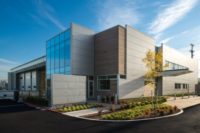Chamberlin Roofing & Waterproofing Takes Texas’ Landmark Love Field to New Heights

Texas-based Chamberlin Roofing & Waterproofing has a knack for taking on historic building projects like the recently completed renovation of Love Field. All photos courtesy of Chamberlin Roofing & Waterproofing.

















With nearly 120 years of experience providing professional building services, it’s no surprise that Chamberlin Roofing & Waterproofing has a habit of taking on historical projects. The list of significant structures the Texas-based commercial roofing contractor has worked on includes numerous aged courthouses and civic centers throughout Oklahoma and Texas, including the Lyndon B. Johnson Presidential Library and Lady Bird Johnson Center in Austin.
Each project provided its own fair share of challenges that required the company’s management team and work crews to stay flexible, versatile and innovative — not exactly traits that one might associate with a company founded in the 19th century.
“At Chamberlin we believe we must be in a constant state of improvement to continue to earn our reputation of excellence,” said David Neal, executive vice president.
The company started providing professional weather stripping services in Michigan in 1897, and moved to Texas in 1978, with the opening of its first office in Houston. Following the relocation, it focused primarily on waterproofing, but then added roofing and sheet metal to the installation-service line in the 1990s — when market demand outweighed the existing supply of available roofing contractors. Since then, Chamberlin’s grown to serve Texas, Oklahoma, Louisiana, Arkansas and New Mexico with offices in Austin, Houston, Farmers Branch, and San Antonio, Texas, as well as Moore and Tulsa, Okla.
Chamberlin currently has roughly 700 non-union employees that specialize in roofing and sheet metal; waterproofing and caulking; building and garage restoration; and leak maintenance and roof repair. Remedial construction for the entire building envelope is also considered a strong suit, along with historical restoration.
Love is Hard
Skills in both of those areas were on display as part of the Love Field Modernization Program — a public effort to renovate and maintain one of Texas’ landmark airports.
Love Field’s importance to Texas — and the nation as a whole — dates back to World War I, when it became the chief training ground for biplane pilots who fought over the battlefields of western Europe.
It was also where President John F. Kennedy and First Lady Jackie Kennedy landed on Nov. 22, 1963, just hours before his assassination in downtown Dallas. By the end of that day, Vice President Lyndon Johnson was sworn into office aboard Air Force One on the Love Field tarmac before flying to Washington, D.C. The Texas Historical Commission designated the airport a historical site in 2003.
The $519 million restoration project included the complete renovation and expansion of a passenger terminal, construction of new concourses, a larger baggage claim area and a bigger ticketing wing.
Chamberlin won the job from general contractor Hensel Phelps to re-roof the existing terminal, and install: a 450,000-square-foot torch-applied Soprema two-ply modified bitumen roofing system; a 45,000-square-foot GAF PVC roof on the main canopy at the airport entrance; and a 40,000-square-foot roof system on a roadway canopy. Crews also installed 12,000 lineal feet of Hickman aluminum coping on all of the roofs combined.
Since the facility is still a working airport with continuous pedestrian traffic and safety requirements mandated by federal law, access to different roof areas was a challenge, officials said. For example, the 10-person crew had just a 24- to 48-hour window to tear off and replace the roof sections above the boarding gates and Transportation Security Administration offices — both high-traffic areas that could only be closed briefly to the public.
However, that was hardly the biggest obstacle they encountered on the project, which took four years to complete. While installing the new roof above the baggage claim area, crews discovered a major deficiency in the building’s construction that caused an improper slope for drainage.
The roof deck was mostly flat in areas where it should be sloped to allow for water runoff to reach the drains, thus creating a wavy effect across the rooftop. One light rain shortly after the discovery confirmed fears that water pooling would become a major issue.
“Chamberlin immediately started working on a plan to rectify the situation, redesigning the roof installation on the spot,” said Deric Mount, roofing and sheet metal project manager.
To start, Chamberlin crews removed the already-installed insulation and reapplied it, adding additional insulation (up to two feet in some places) to fill in the flat areas and raise them. Once the roof was leveled at the appropriate slope, crews installed the two-ply Soprema modified bitumen roofing system. The finished product resulted in the roof draining water properly without schedule interruptions to the overall project.
“We teach our project teams the importance of being proactive and mindful, especially when challenging situations arise,” Executive Vice President Art Canales said. “It takes a team truly working together to come up with some of the creative solutions to face the many challenges in construction.”
Strong on Safety
Despite the challenges, scope and length of the Love Field project, there were no safety incidents reported. Chamberlin management emphasizes worker safety as a core value, and implements a comprehensive plan with the following key elements:
- Effective education and training programs
- Safety planning and emergency preparedness
- Auditing and evaluation
- Strong leadership from upper management
- Vehicle safety
“All of these components build the overall safety culture of our company’s workforce,” said Bill Lawson, vice president of operations. “Bottom line: you can’t get the job done without the guys in the field, and you need them to be safe. And that culture starts from the very top of the organization. It’s what we do.”
Chamberlin uses a comprehensive behavioral-based safety orientation training process that covers general jobsite safety awareness and hazard recognition. Each new hire also attends a 10-hour Occupational Safety and Health Administration (OSHA) course within the first month that focuses on hazard and injury reporting, fall protection, ladder safety, scaffold safety, proper lifting and vehicle safety.
In addition, all project managers, superintendents, and foremen are required to complete a 30-hour OSHA course, with refresher training annually. The company often hosts ‘safety’ parties and issues safety-bonuses to deserving employees that keep projects moving on schedule.
The roofing industry has taken notice too, bestowing Chamberlin with numerous safety accolades including: the Associated Builders and Contractors (ABC) STEP Diamond status; the 2015 Associated General Contractors (AGC) Outstanding Achievement in Jobsite Safety; and the AGC’s Annual Safety Award for three consecutive years.
Continued Growth
Even with its long history, Chamberlin’s executive team is not resting on the company’s laurels and is focused on future growth.
In August, the company moved its Dallas-area headquarters to a new, 28,000-square-foot building in nearby Farmer’s Branch. The facility includes a 14,000-square-foot warehouse space that is ideal for Chamberlin’s own sheet-metal fabrication shop and is able to accommodate future growth. The company added 16 new hires alone at headquarters in 2015, and is looking to expand the staff at its Austin office this year.
Though the company is not immune to the recruiting and skilled labor shortage problems impacting the entire roofing industry, Lawson said turnover is not a huge issue because of Chamberlin’s team-first approach to working with customers and completing jobs.
“We treat everyone like they matter and that they’re part of the team that gets things done,” said Lawson, who started with Chamberlin as a field superintendent 18 years ago. “They know we care about them because we show that we care about them and appreciate what they do.”
Looking for a reprint of this article?
From high-res PDFs to custom plaques, order your copy today!














